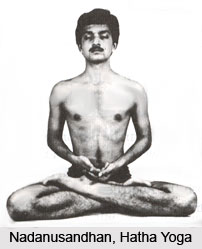 Nadanusandhan or Hatha Yoga is practiced in order to focus on physical and mental strength building postures. The pranayama and mudra techniques in hatha yoga are followed to bring about the retention of prana within the body. This retention of "Prana" instigates the profound `inner heat`, which stirs the sleeping Kundalini from the slumber. As a result, when Kundalini rises up, and pierces the chakras and granthis, the yogi in deep introspection is said to be able to hear a `subtle` or `inner sound` (Nadam) within the right ear. The sound can also said to be the subtle vibration within. This Nada or Shabda, is considered to be Kundalini-Shakti itself manifested as sound or vibration. That is the reason why one of its titles is Shabda-Brahma (Brahma`s sound). As the Kundalini force ascends in the Nadi, the sound becomes increasingly defined and intense. The entire mind and body of the yogi is fully absorbed in its vibrations.
Nadanusandhan or Hatha Yoga is practiced in order to focus on physical and mental strength building postures. The pranayama and mudra techniques in hatha yoga are followed to bring about the retention of prana within the body. This retention of "Prana" instigates the profound `inner heat`, which stirs the sleeping Kundalini from the slumber. As a result, when Kundalini rises up, and pierces the chakras and granthis, the yogi in deep introspection is said to be able to hear a `subtle` or `inner sound` (Nadam) within the right ear. The sound can also said to be the subtle vibration within. This Nada or Shabda, is considered to be Kundalini-Shakti itself manifested as sound or vibration. That is the reason why one of its titles is Shabda-Brahma (Brahma`s sound). As the Kundalini force ascends in the Nadi, the sound becomes increasingly defined and intense. The entire mind and body of the yogi is fully absorbed in its vibrations.
Purpose of Nadanusandhan
Anusandhana roughly translates as `being intent upon` or `attending to`. Hence, the practice of Nadanusandhan (Nada + Anusandhana) is defined as fixing one`s attention upon the inner sound. The entire purpose of the practice is to bring about the dissolution of mental modifications (Chitta-Vritti). This is also the ultimate aim described in Patanjali Yoga sutra where the resulting state is Laya (absorption). To achieve this state of mind, the Yogi has to sit in the `posture of deliverance and he has to apply Sambhavi-mudra, i.e. concentrating upon an inner object. All the external sensations are barred out and the mind is solely withdrawn to the inner "Nada". This state is aided by closing the ears with the thumbs of each hand and using the fingers to close eyes, nostrils and mouth.
Techniques of Hatha Yoga
Hatha yoga techniques, in succession, move from outward conquest of physical self (cleaning and pranayama) to that of achieving the state of Samadhi (nadanusandhanam). This is in stark contradiction to the believers that convey that Hatha yoga is all about healthy body training and nothing else.
Hatha-yoga has a systematic approach to spiritual attainment. It progressively `internalizes` the practice engaging the student in an inward journey from the physical body to the most refined mental structures, with the purpose to eventually reveal an expanded and divine sense of identity. The benefits to be derived from the more advanced stages of Kumbhaka, in which the flow of air into and out of the body is drastically (sometimes hard to believe) restricted for prolonged periods, may seem obscure. Also, some doubts may arise regarding the probability of such techniques actually being performed.
To understand the powerful utility of such practices, it is important to acknowledge the role of prana as the subtle, but all important life energy. Prana is more fundamental source of nutrition than oxygen, food, or anything else that is ingested into the body. The experienced yogi is able to control the breathing cycle to the extent that the breath is suspended for hours. All this is feasible precisely because he has learnt to retain prana within the innermost core of his being.
The stored energy in the sushumna-nadi can be utilized by taping into the infinite reservoir of Kundalini-Shakti. Limited by the known limitations of the body, it is lot hard to believe about the yogic feats offered in the traditional literature.
The fact that extraordinary instances of endurance and control over physiological processes do occur is beyond question. If hatha yoga techniques seem hard, unconventional and rigorous, so is the intensity of the results yielded by it.




















